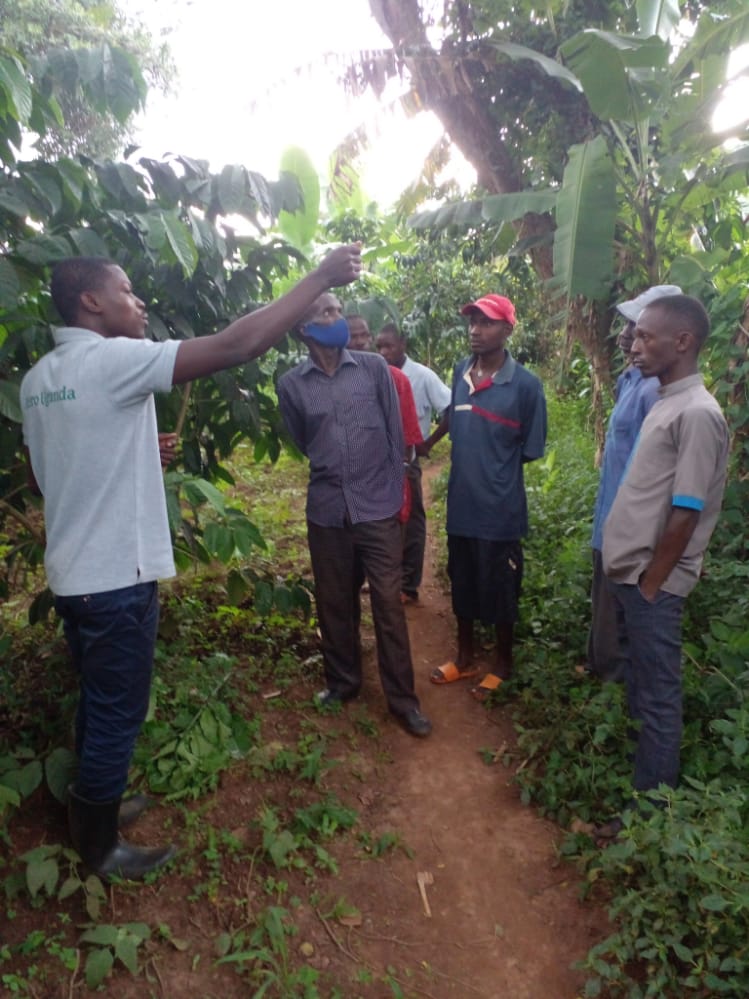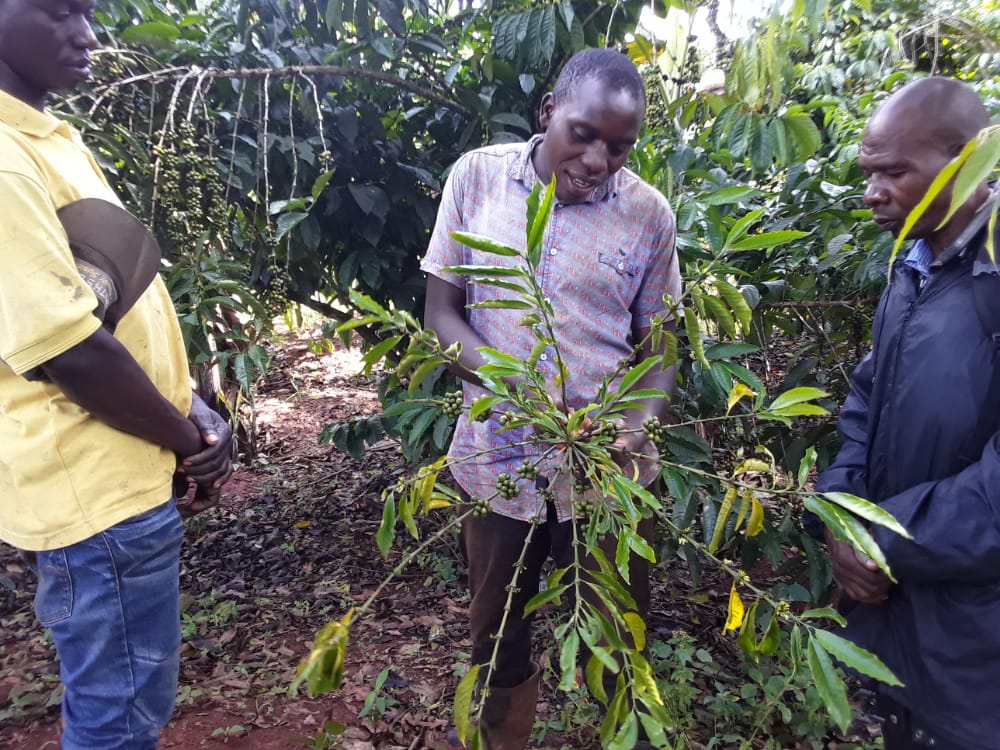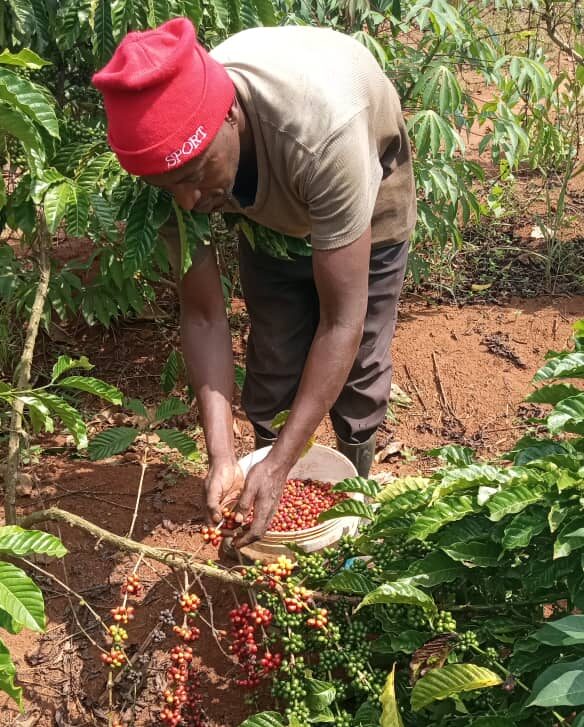Uganda is a nation of small farmers. 76% of the population of 46 million lives in the rural areas, and the great majority are small farmers growing both food and cash crops on less than 3 acres of land. Agriculture accounts for 70% of employment; occupies half of the land; and provides half of all exports and one-quarter of Uganda’s Gross Domestic Product. It is a leading sector for economic growth as well as for increasing the income of Uganda’s poorest families (World Bank, 2018).

Small farmers grow plantains, corn, and beans for food, and the majority grow coffee for income. Approximately 500,000 families depend on coffee production for their principal income (Uganda Coffee Development Authority, 2018). 15% of the coffee farmers grow Arabica and 85% grow Robusta coffee. There are six distinct coffee growing regions in the country: Central, Western, South-Western, Eastern, South-Eastern, and Northern.
Robusta coffee is grown in the Central, Eastern, Western and South-Eastern Uganda where elevations are less than 1,200 meters above sea level. Arabica coffee requires higher elevations, and it is grown primarily on the slopes of Mount Elgon in the East and Mt. Ruwenzori and Mt. Muhabura in the South-Western Region where altitudes are 1,500 to 2,300 meters above sea level.
Arabica coffee commands a higher price in the global market, and most of the projects for increasing coffee production and income have been in areas and with farmers that grow Arabica. However, 85% of the coffee farmers in Uganda are limited to growing Robusta coffee at lower elevations, and they too can increase their income.
The Central region has the highest concentration of Robusta coffee farmers, with 38% of the total. SID’s project is located in Luweero District, in the heart of the Central region. Luweero has 702 coffee-producing villages and more than 21,000 coffee-farming families. Income from coffee ranges from $64 to $256 a year, but farmers have not had any significant technical assistance in increasing their income. They not only have the ability to increase their productivity, processing, price, and income, but many can also increase the amount of land they dedicate to coffee. Farmers can at least triple their income and graduate from poverty.
SID is using a regional approach that gives all of Luweero District’s coffee farmers a chance to graduate from poverty. All farmers learn the practices for graduating from poverty with Robusta coffee and they are encouraged to adopt them. Farmers th at agree to adopt all of them receive technical assistance; conserve land and increase their productivity, price, and income; and become examples for others to follow. Luweero has two rainy seasons and two dry/harvest seasons. The rainy seasons are March to May and September to November. The dry/harvest seasons that follow them are June to September and mid-November to February. The November to February season is the main harvest season. Farmers dry their coffee in the husk for five or six weeks and sell the dried cherries (kiboko) to local intermediaries rather than hull their kiboko and sell the beans directly to exporters for a higher price. Farmers measure their coffee plots in 1/4 acres; they have 2 to 7 1/4 acres of coffee; and their productivity in kiboko is 200 to 250 kilos when they could produce 600. The major conservation practices are harvesting rainwater by digging water retention ditches and mulching the coffee trees to maintain moisture in the soil.
at agree to adopt all of them receive technical assistance; conserve land and increase their productivity, price, and income; and become examples for others to follow. Luweero has two rainy seasons and two dry/harvest seasons. The rainy seasons are March to May and September to November. The dry/harvest seasons that follow them are June to September and mid-November to February. The November to February season is the main harvest season. Farmers dry their coffee in the husk for five or six weeks and sell the dried cherries (kiboko) to local intermediaries rather than hull their kiboko and sell the beans directly to exporters for a higher price. Farmers measure their coffee plots in 1/4 acres; they have 2 to 7 1/4 acres of coffee; and their productivity in kiboko is 200 to 250 kilos when they could produce 600. The major conservation practices are harvesting rainwater by digging water retention ditches and mulching the coffee trees to maintain moisture in the soil.
Project Goals
There are 702 coffee-producing villages in Luweero District, and at least 30 coffee-producing families per villages. The four goals of the project are:
Project Activities
 The five core activities of the approach are:
The five core activities of the approach are:
1) Representatives of farming villages take the lead in defining the practices they need to adopt to conserve land and increase income from the common cash crop.
2) Local officials, teachers in secondary schools, radio stations, and others teach the practices and encourage their adoption.
3) SID conducts demonstration shows in the practices.
4) SID provides technical assistance in the practices in villages that agree to adopt all of them.
5) Women receive additional assistance in setting personal goals, solving common problems, making business plans, and learning the best practices for second businesses of their choice.
Results
The General Population. In March 2022, farmers in each county began the project by defining the practices they needed to adopt to increase their income from coffee. They agreed upon 32 practices: 10 practices for increasing productivity; 8 for getting a higher price; 6 for conserving their land; and 8 for making better business decisions.

Early-Adopter Villages. Farmers made a 7% increase in productivity by pruning, shading, and fertilizing their trees. They also have a lot of gaps in the coffee plots, and they are working on filling them with coffee trees which bodes well for increasing productivity and income in years to come.
Farmers can sell their coffee in three ways. In 2022, the farmers in the program decreased the amount of fresh cherries they sold from 28% to 24%, and increased the amount they sold as dried cherries from 45% to 55%. However, the amount of their harvest that farmers hulled and sold as FAQ green fell from 26% to 21%. We will be focusing our efforts on increasing the hulling in this second year of the project.
